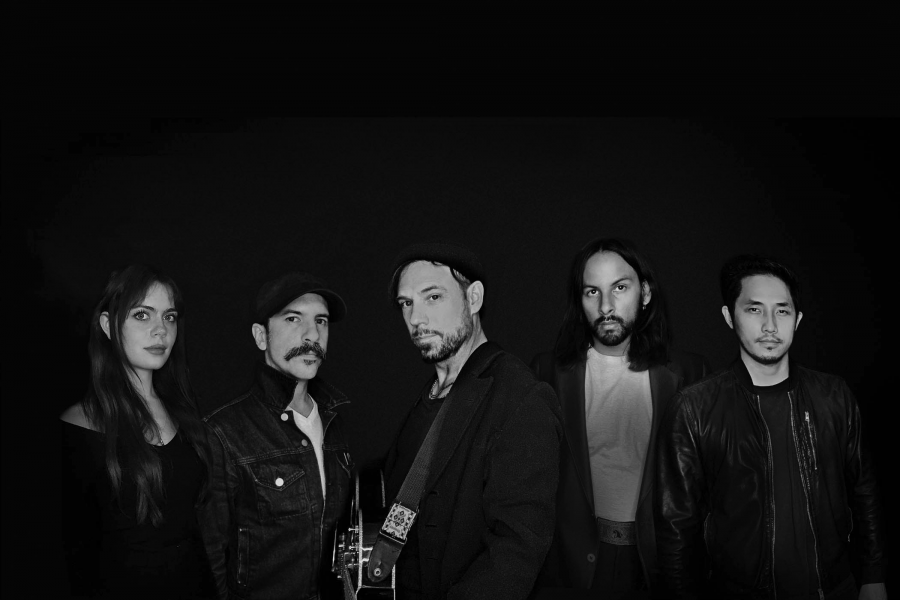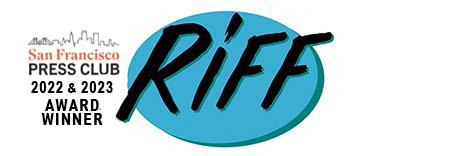Interview: Mikel Jollett on The Airborne Toxic Event performing with SF Symphony

The Airborne Toxic Event, courtesy.
Sandwiched between the Salt Lake City and Seattle dates on The Airborne Toxic Event tour in support of its critically acclaimed 2020 album, Hollywood Park, is a show with the San Francisco Symphony on July 16.
The Airborne Toxic Event and San Francisco Symphony
Bruce Anthony Kiesling (conductor)
7:30 p.m., Saturday, July 16
Davies Concert Hall
Tickets: $25-$195.
Originally scheduled for 2020, it got pushed to now, leaving Mikel Jollett and his bandmates with several things to concentrate on simultaneously.
“We’re rehearsing more for that one show than the entire rest of the July tour,” Jollett said over a video call from his L.A. home last week. “All of our rehearsals are focused just on this one show. It’s challenging; it’s a lot because we play songs in different keys. We play songs with different timings.”
Jollett explained how when it’s just his band on stage, the members can look at each other to get back on track. But that doesn’t work when there are dozens of other musicians behind them who are playing off a sheet music chart—everyone has to stick to that chart. If his part starts on the 37th beat, he needs to physically count off every beat to make sure he enters on time.
From the band’s founding in the early aughts, the Airborne Toxic Event has always incorporated orchestral elements. Strings and brass have often been a signature for singer-guitarist Jollett, keyboardist Steven Chen, drummer Daren Taylor and bassist Adrian Rodriguez (founding violinist Anna Bulbrook left in 2019 and was recently replaced by Mimi Peschet).
Jollett, the bandleader, often invited guest string quartets and brass musicians to record and arrange.
“They say the violin mimics the sound of the human voice because it doesn’t have frets,” Jollett said. “So there’s just more room for that kind of stretching and contraction, much like a human vocal cord, and it tells stories. There’s a lot more room for a violin to be sort of emotive. You take that palette, and you go broad with it with the whole symphony. Suddenly, there’s all these new possibilities. There’s all these things that you can do with your music you weren’t able to do before, between the timpani and drums and the woodwinds and everything.”
The Airborne Toxic Event began creating symphonic arrangements in 2010, when the band first played with a symphony. Los Angeles composer Douglas Pipes has had the lion’s share of the technical chart-writing work, Jollett said. The process included Jollett humming the various parts, with Pipes translating that to instrument groups and making recommendations.
The band has performed with the likes of Colorado Symphony, Louisville (Kentucky) Orchestra and Pacific (Orange County) Symphony.
“Playing with the symphony itself is always very nerve-wracking because you’re, like, on a spaceship deck,” he said. “There’s like 63 people behind you, and you’re just like trying not to mess up.”
He called getting the invitation to perform his songs with the San Francisco Symphony a great honor because it’s so renowned in the orchestral music world.
“Very highly trained musicians are going to come in and play my stupid songs,” he said self-deprecatingly.
The band and the San Francisco institution have been in talks to collaborate for several years, he said. It’s something he’s been looking forward to for a while. The experience is both challenging and invigorating and makes him feel alive as an artist.
The San Francisco Symphony will be conducted by Bruce Anthony Kiesling, who’s worked both with the band and the SF Symphony before. In January, he led the local musicians alongside actor Darren Criss, for example.
In an email, Kiesling said that he first worked with the Airborne Toxic Event in 2013.
“Looking again at these songs and arrangements, what strikes me, again and again, is how dramatic the songs are,” Kiesling said. “Many of the songs are mini stories with a clear point of attack and development. They often include a catharsis or an epiphany. This makes casting them with an orchestral palette particularly effective.”
Hollywood Park was inspired by the death of Jollett’s father and the ensuing grief that followed for the songwriter. It’s a companion piece to a New York Times bestselling memoir of the same name, released at the same time in 2020, that chronicles a difficult childhood. Jollett, his mother and brother lived in a commune that became a cult in Southern California that they had to escape. He was separated from his father for years, before the father, an ex-con, reentered his life, and the two became very close.
Jollett, his brother and mother moved north to Tomales Bay in Marin County, then to Oakland and Berkeley, and later to Salem, Oregon. He would go on to do well at school, graduating with honors from Stanford in 1996. He became a fiction writer and journalist before starting The Airborne Toxic Event.
He said he still feels a strong connection to the Bay Area, even though life in Oakland and Berkeley remained rough.
“It just happened to be what we were going through—a lot of time spent at the food bank, at the church, trying to get government cheese, or whatever,” he said. “The schools were rough, and the neighborhood was rough. Our place was burglarized, and people were beaten. It was a tough time. But having said all that, every time I’m back in the Bay Area, there’s always this pull, this nostalgic pull of these moments that were so fraught with meaning and were so consequential for my whole life.”
Stanford, meanwhile, felt less like the Bay Area and more like a “nerdy Disneyland that had a lot of homework,” but his professors were great and the education crucial to his development, he added.
It took Jollett about four years to write the book. He was still dealing with his grief at the time, which affected his physical and mental health. He would spend days locked in a small studio he built in his home—the same studio he was in for this interview and did nothing but write for months at a time.
Finding positives in a dark place
Mikel Jollett is an outspoken supporter for social change. His Twitter feed is full of commentary on the news of the day, which for weeks has seemed like a tidal wave of injustice and the loss of freedoms, led by the Republican Party and the Republican-controlled Supreme Court.
“There is this sense of this unraveling of the fabric of American life. In some ways that’s good. … The unearthing of the innate racism and sexism and bullshit patriarchal horseshit that underlies the whole society, I feel, has become very, very plain. If you’re a man, it’s hard to look around and keep your head in the sand about women being second-class citizens in this society at this point. …
You’re in this position in public life where you don’t want to just express hopelessness, and sometimes people are looking to you for some kind of, ‘OK, what do we do now?’ In the last two weeks, a lot of what I felt is just frustration, sadness. My wife and I cried last Friday, disheartened with the sense that the country’s just irreparably broken. … Hateful and vengeful and lost in propaganda, racism, homophobia and sexism. It’s horrible. …
And that’s sort of how it works for change: Despair becomes anger, anger becomes change, and I feel like a lot of us are angry. I think the Republican Party thinks the anger is going to die down and we’re all just kind of go back to being distracted. And I just don’t see how that happens when you’re telling half the population their second-class citizens. …
That’s the part of me that feels a little bit of hope, but that hope is beyond this firewall of anger. The feeling of, like, ‘Sign me up! Where do we go? I’m there. You want money? You want time? You want a song? Should we march? What are we doing? I think that some of the frustration that a lot of people have with the Democratic Party right now is [that] there’s a real sense of ‘let’s fucking go, what’s the plan?’ Just today, Biden, said that he would approve eliminating a filibuster in the case of protecting choice rights. I think that’s a step in the right direction.”
This from someone who’d never journaled a day in his life. He didn’t know at first that an album would also come from the project, but he knew from day one that there would be a book. And Jollett aimed high. He wanted something that could be brought up in the same conversations as some of his favorites like “I Know Why the Caged Bird Sings,” “Angela’s Ashes” or “Dreams of My Father.”
He also wanted to write something that would be important to people who knew nothing about him or The Airborne Toxic Event.
Since about two years have passed since Hollywood Park was released, the band’s fans have had time to get acquainted with the new songs and have been singing them back to the band at shows, Jollett said, adding that he’s also proud that it has been the band’s most critically acclaimed album.
“To not be able to play it [in 2020] was really disappointing, because sometimes there’s this feeling … like it doesn’t really exist until you’ve played it live—you haven’t seen people respond to it, react to it with you in a room, and so much of music is about that,” he said. “It’s a record about my father and what his life was, and his death and everything, and to have these thousands of people who are themselves moved by that … makes the project feel very alive.”
Jollett and the band have incorporated an element of storytelling into their shows for the first time, explaining what led to the moments of inspiration for the new songs and expand on the stories in the book. The rest of the band is scoring his stories in real-time, which he said is much harder than it might seem to an audience and is a creative risk, but that it’s part of the draw.
“When you take risks on stage, people can sense that risk. People can tell when you’re playing it safe. And people can tell when you’re actually putting something out there. … Rock and roll is part revival, part confession and part circus, and storytelling in the midst of a rock and roll show has confession, revival and circus.”
The Airborne Toxic Event will be performing some of their Hollywood Park songs with the San Francisco Symphony. Jollett said much of the new material was originally written and recorded in a way that lends itself to orchestral arrangements—something for which he credits Peschet, who has a strong classical violin background.
The title track, with its grand horns and galloping percussion, is a great example of a massive sound that will be great with a symphony, he said.
“[With] that record; we were really trying to capture this these very large themes of generational change and grief and loss and sorrow and rebirth and regrowth and stuff,” he said. “Sometimes you capture that with just acoustic guitar and a whisper, and sometimes you capture it with 68 musicians. I think the trick is to be able to do both.”
Follow editor Roman Gokhman at Twitter.com/RomiTheWriter.
